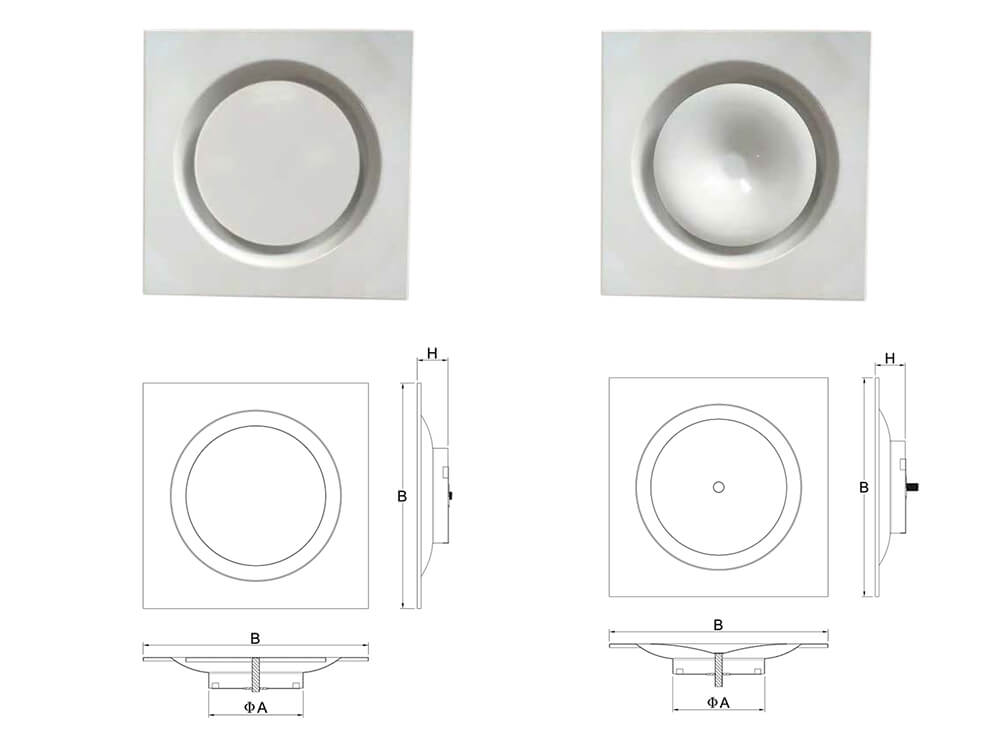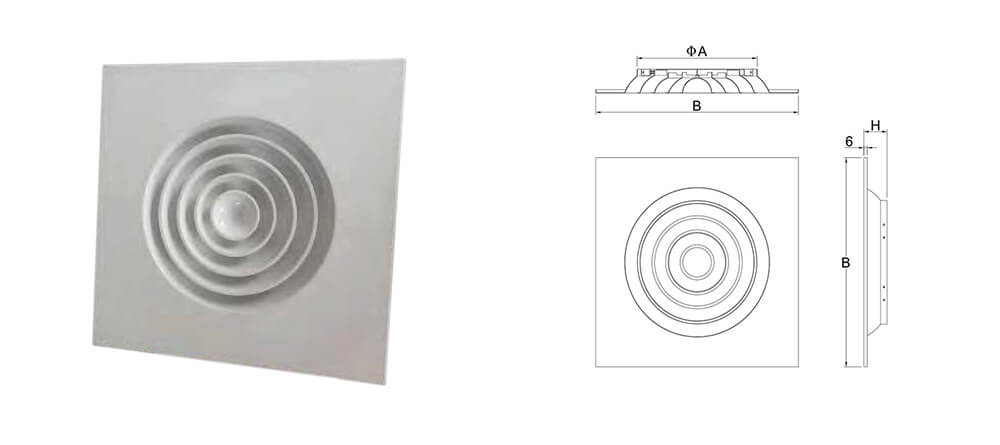In this section, we explore the foundational aspects of plaque diffusers, shedding light on what they are and their critical role in HVAC systems. This knowledge forms the basis for understanding their impact on air distribution and indoor climate control.
What are Plaque Diffusers?
Plaque diffusers, characterized by their flat, plaque-like appearance, are essential in distributing air evenly across a room. They are engineered to blend efficiency with aesthetic appeal, making them a preferred choice in various settings. The primary role of plaque diffusers is to enhance indoor air quality and thermal comfort by regulating air distribution and minimizing drafts.
The Role of Plaque Diffusers in HVAC Systems
- Enhancing Air Distribution: The primary function of plaque diffusers is to evenly distribute air across a room. They do this by dispersing air in various directions, reducing drafts and cold spots.
- Contribution to Indoor Air Quality: By ensuring efficient air circulation, plaque diffusers play a vital role in maintaining optimal indoor air quality. This is crucial for both comfort and health in enclosed spaces.
Understanding Their Mechanism
- Working Principle: Plaque diffusers work on the principle of multi-directional air discharge. The design allows for a spread of air in different directions, creating a more uniform airflow and temperature distribution within the space.
- Adjustability and Control: Some plaque diffusers offer adjustability features, allowing for control over the direction and volume of airflow. This adaptability makes them suitable for a variety of room sizes and shapes.
Design and Working Principle
This section delves deeper into the structural design and working mechanics of plaque diffusers. Understanding these elements is key to comprehending how they efficiently manage airflow within HVAC systems.
Detailed Design of Plaque Diffusers
- Structural Composition: At its core, a plaque diffuser consists of a flat or slightly convex panel. This panel typically features multiple perforations or slots, designed to facilitate the even distribution of air.
- Aesthetic Integration: Beyond functionality, plaque diffusers are often designed with an emphasis on aesthetic appeal. They come in various finishes and styles, allowing them to seamlessly integrate into different architectural designs.

The Working Principle Behind Plaque Diffusers
- Dispersing Air Effectively: The central concept of plaque diffusers revolves around dispersing air radially in various directions. This design ensures a more uniform spread of air, minimizing drafts and hot or cold spots in a room.
- Thermal Comfort: By distributing air evenly, plaque diffusers play a significant role in maintaining consistent thermal comfort throughout the space, which is crucial in both residential and commercial settings.
Understanding Airflow Dynamics
- Radial Airflow Pattern: The unique design of plaque diffusers creates a radial airflow pattern, which enhances air mixing and reduces the likelihood of stagnant air zones.
- Variable Air Volume (VAV) Compatibility: Many plaque diffusers are designed to be compatible with VAV systems, allowing for flexible airflow control based on occupancy and temperature requirements.
Types and Varieties of Plaque Diffusers
Catalog of HVAC Ceiling Diffusers(Including Plaque Diffusers)
Plaque diffusers come in various designs and forms, each tailored to meet specific airflow and aesthetic requirements. In this section, we examine the different types of plaque diffusers, highlighting their unique features and applications.
Standard Plaque Diffusers
- Basic Design and Application: Standard plaque diffusers are characterized by their simple, functional design. They are typically used in office spaces, classrooms, and retail environments where basic air distribution is required.
- Features: These diffusers usually have a fixed pattern design, directing airflow in predetermined directions that suit general purposes.
Adjustable Plaque Diffusers
- Enhanced Control Over Airflow: Adjustable plaque diffusers offer the ability to alter the direction and volume of airflow. This adaptability makes them ideal for spaces where user comfort and variable air patterns are a priority.
- Mechanism of Adjustment: The adjustability is often achieved through movable blades or panels, allowing users to tailor the airflow to specific needs and preferences.
Architectural Plaque Diffusers
- Blending Function with Aesthetics: Architectural plaque diffusers are designed to complement interior design elements. They are often used in high-end commercial spaces, hotels, and bespoke residential settings.
- Customization Options: These diffusers come in a range of finishes and materials, and can be customized to match the décor and architectural style of the space they are installed in.
Specialized Plaque Diffusers
- Innovative Designs for Specific Needs: Some environments require diffusers with specialized designs, such as those that minimize noise, manage high airflow rates, or address specific architectural challenges.
- Examples and Applications: This category includes diffusers designed for healthcare facilities, where hygiene and air quality are paramount, or for industrial settings, where durability and high-performance airflow management are essential.

Material and Construction
In this section, we delve into the materials and construction aspects of plaque diffusers, and essential factors that significantly influence their performance, durability, and integration into various spaces.
Common Materials Used in Plaque Diffusers
- Aluminum: A popular choice for its lightweight and corrosion-resistant properties, aluminum is widely used in manufacturing plaque diffusers. It’s ideal for environments with fluctuating temperatures or moisture levels.
- Steel: Known for its strength and durability, steel plaque diffusers are often utilized in commercial and industrial settings where longevity and robustness are crucial.
- Plastics and Composites: In applications where cost-effectiveness and versatility are priorities, plastics and composite materials are used. They offer ease of customization in terms of colors and shapes but might lack the durability of metal options.
Quality of Construction and Its Impact
- Precision Engineering: The efficiency of plaque diffusers heavily depends on the precision of their engineering. This includes accurate perforations and well-designed airflow paths to ensure optimal performance.
- Aesthetics and Functionality: The construction quality also affects the aesthetic appeal of the diffuser. High-quality construction can lead to a sleeker, more integrated look that complements the interior design.
- Durability and Longevity: Well-constructed plaque diffusers withstand the test of time, maintaining their functionality and appearance over prolonged use.
Innovations in Material and Design
- Eco-friendly Materials: There is a growing trend towards using sustainable and environmentally friendly materials in HVAC components, including plaque diffusers.
- Advanced Manufacturing Techniques: The adoption of advanced manufacturing techniques like 3D printing is beginning to influence the design and production of plaque diffusers, allowing for more intricate designs and efficient production processes.
Performance and Efficiency
In this section, we focus on the performance and efficiency of plaque diffusers, essential factors in determining their effectiveness in HVAC systems. Understanding these aspects helps in assessing their contribution to overall system efficiency and climate control.
Efficiency in Air Distribution
- Uniform Air Spread: Plaque diffusers are designed to distribute air uniformly across a space, which is crucial in avoiding hot or cold spots and ensuring consistent temperature control.
- Reduced Energy Consumption: By optimizing airflow patterns, these diffusers can contribute to lower energy consumption. Efficient air distribution means HVAC systems do not have to work as hard to maintain desired temperatures.
Impact on HVAC System Performance
- Enhanced Air Mixing: The design of plaque diffusers facilitates enhanced air mixing, which can improve the overall efficiency of the HVAC system.
- Noise Reduction: Good-quality plaque diffusers are also effective in reducing operational noise, contributing to a more pleasant indoor environment.
Case Studies and Real-world Applications
- Analyzing Performance in Different Settings: Including case studies or examples where plaque diffusers have made a significant impact in various environments, such as commercial offices, healthcare facilities, or educational institutions.
- Comparative Analysis: Compare the performance of plaque diffusers with other types of diffusers in real-world scenarios to highlight their efficiency and effectiveness.
Advanced Efficiency Considerations
- Compatibility with Variable Air Volume Systems: Discuss how plaque diffusers perform in conjunction with variable air volume (VAV) systems, which are increasingly common in modern HVAC installations.
- Long-Term Efficiency Benefits: Explore the long-term benefits of installing plaque diffusers, such as reduced wear and tear on HVAC systems and prolonged system lifespan.

Conclusion
As we conclude our exploration of plaque diffusers, it’s essential to revisit the key insights gleaned from the various aspects covered in this article. Understanding these elements is crucial for HVAC professionals, architects, and building managers in optimizing indoor climate control.
Reflecting on the Essentials of Plaque Diffusers
- Defining Role and Design: We began by defining plaque diffusers and their unique role in HVAC systems. Their design, characterized by a flat, plaque-like appearance, is pivotal in evenly distributing air and maintaining indoor comfort.
- Material and Construction Impact: The choice of materials and construction quality directly influences the durability and effectiveness of plaque diffusers, with each material offering distinct advantages in different settings.
Revisiting Their Performance and Efficiency
- Efficiency in Air Distribution: One of the standout features of plaque diffusers is their ability to provide uniform air spread, significantly enhancing the efficiency of HVAC systems.
- Long-Term System Benefits: Plaque diffusers not only contribute to immediate comfort and efficiency but also offer long-term benefits, such as reduced energy consumption and enhanced system longevity.
Final Thoughts on Plaque Diffusers
- Versatility and Adaptability: From standard designs to adjustable and architectural options, plaque diffusers offer versatility to meet diverse architectural and functional needs.
- A Vital Component in HVAC Systems: The comprehensive overview underscores plaque diffusers as an integral component in HVAC systems, essential for achieving optimal air quality and thermal comfort in various environments.
FAQs: Understanding Plaque Diffusers in HVAC
Common Questions About Design and Functionality
Q: How do plaque diffusers differ from other HVAC diffusers?
- A: Plaque diffusers are distinct in their flat, plate-like design, which allows for a more even and multidirectional spread of air. This differs from traditional diffusers that often direct air in specific, fixed patterns.
Q: Are plaque diffusers suitable for all types of rooms and spaces?
- A: Plaque diffusers are versatile but particularly effective in spaces where even air distribution and aesthetic integration are important. They are commonly used in offices, commercial buildings, and areas where a seamless look is desired.
Installation and Compatibility Queries
Q: Is the installation process for plaque diffusers complex?
- A: The installation process for plaque diffusers is relatively straightforward, similar to other types of diffusers. However, it’s important to ensure correct sizing and compatibility with the existing HVAC system for optimal performance.
Q: Can plaque diffusers be used with any HVAC system?
- A: Plaque diffusers are generally compatible with most HVAC systems, but it’s crucial to check specific system requirements, especially regarding airflow patterns and volume control.
Performance and Efficiency Concerns
Q: Do plaque diffusers improve the efficiency of HVAC systems?
- A: Yes, due to their design, plaque diffusers can enhance HVAC efficiency by providing uniform air distribution, which helps in maintaining consistent room temperatures and reducing hot or cold spots.
Q: Are there energy-saving benefits to using plaque diffusers?
- A: Plaque diffusers contribute to energy efficiency by improving air circulation, which can reduce the workload on the HVAC system and lead to energy savings over time.
Material and Maintenance Considerations
Q: What materials are typically used in plaque diffusers?
- A: Common materials include aluminum, steel, and plastic composites. The choice depends on the specific application, aesthetic preferences, and budget considerations.
Q: How often do plaque diffusers require maintenance?
- A: Regular maintenance, including cleaning and inspection for damage, is recommended. The frequency depends on the usage and environment, but generally, a check-up every few months is advisable.

If you want to know more, please click below:
- HVAC Linear Slot Diffusers – The Ultimate Guide
- HVAC Egg Crate Diffuser – The Ultimate Guide
- HVAC Jet Nozzle Diffuser – The Ultimate Guide
- HVAC Linear Bar Grilles – The Ultimate Guide
- HVAC Air Swirl Diffusers – The Ultimate Guide
- HVAC Round Ceiling Diffusers – The Ultimate Guide
- Round Ceiling Diffusers – The Ultimate Guide
- HVAC Return Air Grille – The Ultimate Guide
- Exhaust Air Louver – The Ultimate Guide
- HVAC Registers – The Ultimate Guide


